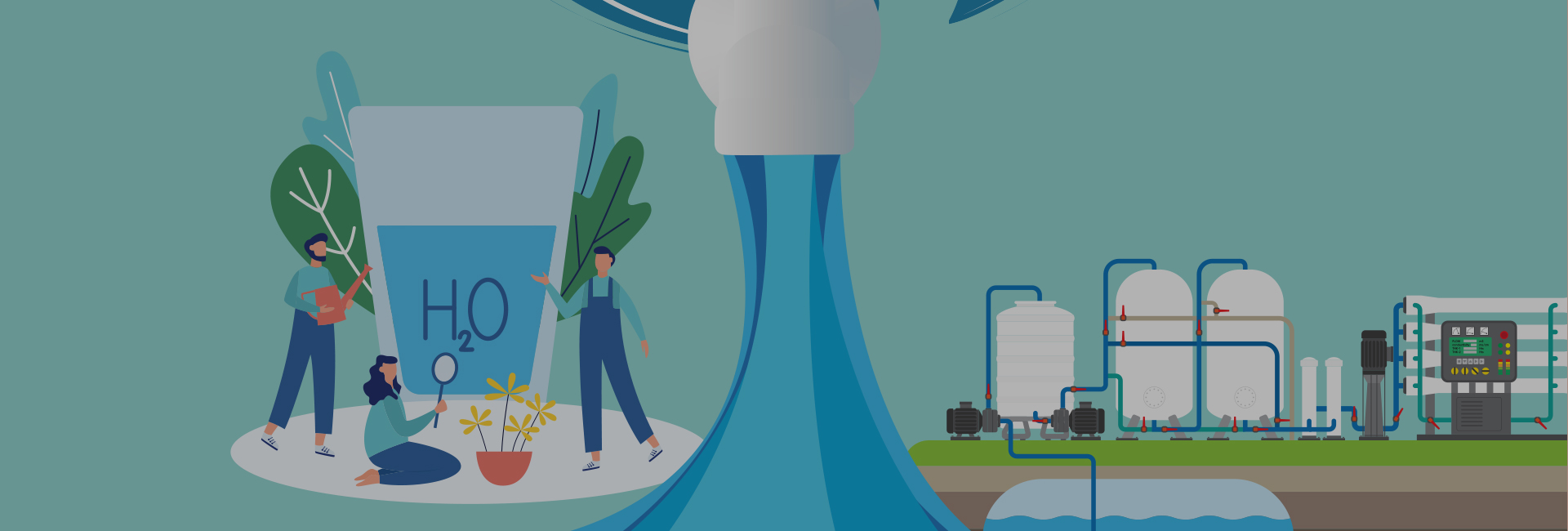
- Water, Nature and Humankind
- K-water Report
-
“K-water helps make Korea a better place where
everyone enjoys clean water with anxiety about its purity”- Written by. Choi Hang-jwa
- Source by. K-water, Water Supply Statistics 2020
- Clean and safe water should be available to everyone. K-water provides safe tap water to drink by drastically improving water quality and water supply infrastructure. K-water works diligently to achieve our goal of ensuring the world’s best optimal water welfare for everyone. To achieve this, K-water has modernized the water supply pipelines and make sure tap water services are available to communities vulnerable to water supply shortages through our digitalized water supply systems.
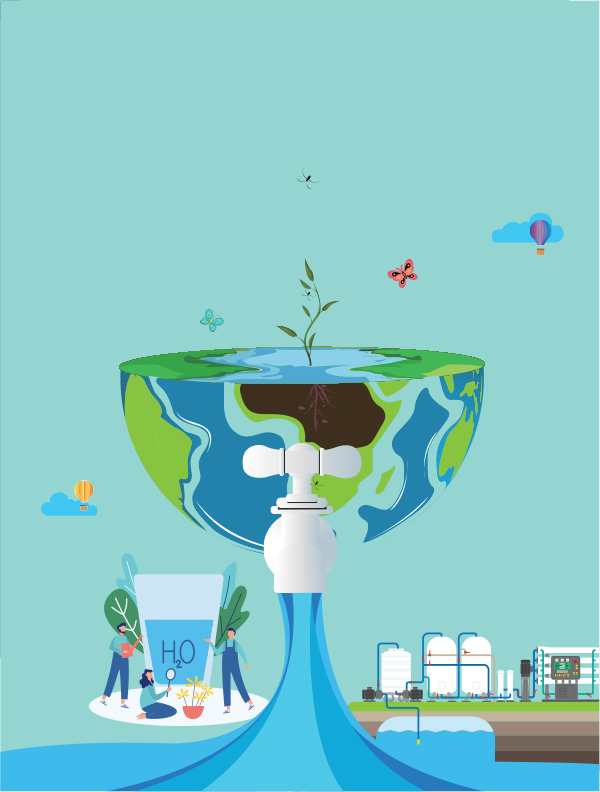
First step toward water welfare, advanced water supply infrastructure
Some people feel happy when they live in a clean environment; for others, being healthy is the key to happiness. A welfare state means that all citizens can lead a decent, happy life. In this sense, water is no exception because it is a common pool resource that is essential and indispensable for life. Then, what is water welfare? It means that the high-quality benefits associated with water are always available to all citizens, guaranteeing a high quality of life for all. According to water supply statistics, the overall water supply rate is 99.4% in Korea but is slightly lower in rural farming and fishing areas at 96.1%. In 2011, the figures were 97.9% and 87.1%, respectively, resulting in a gap of 10.8%. However, the gap was narrowed down to 3.3% in 2020. Similarly, the water supply population increased from 50,638,000 in 2011 to 52,644,000 in 2020. These statistics indicate that virtually all Korean citizens can instantly access clean and safe water if they turn on their tap.
All these phenomenal changes are a result of K-water’s efforts to improve water welfare. In order to provide healthier and cleaner water, K-water has constantly built water supply infrastructure including dams and sewage and water supply systems and replaced old water supply pipes with new ones. K-water refused to rest on its laurels, however. Instead, it adopted a grand vision of “realizing inclusive water welfare” under which it has been implementing a variety of projects. As a result, the scheme of restricted water supply has been abolished in Namhae county, 45 years after the sewage and water supply system was introduced in the region. K-water built a groundwater reservoir in Daeyijakdo, Ongjin-gun, Incheon, ensuring stable water supply for some 300 residents of the island. It was the first groundwater reservoir ever built on an island in Korea.
Nonetheless, national water welfare is not yet complete as there are still gaps in the water services received by citizens between regions, social classes, and geographic locations.
K-water is currently in the process of advancing the water supply infrastructure and systems as part of its efforts to provide safer and cleaner water. It is operating and managing 48 metropolitan water supply systems that are responsible for 48% of the country’s entire water supply capacity. It is also managing and supervising 23 local water supply systems operated by contractors while working on the modernization of those systems. In addition, K-water is currently building a smart water supply management system that can integrate metropolitan and local water supply systems by combining its water management knowhow and ICT.
Water supply by year
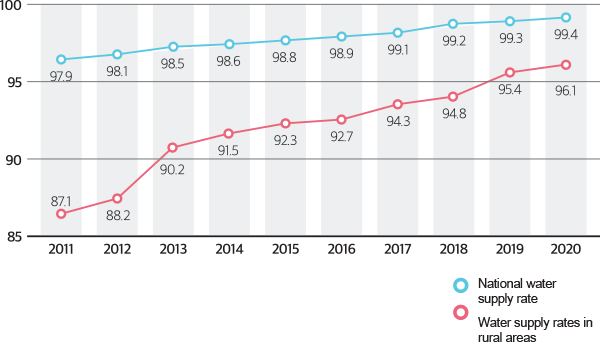
Guaranteeing Access to Clean and Safe Water for Everyone, Shift to a New Water Supply System
K-water is taking various steps to ensure that the country is free from water problems. However, there are still places where metropolitan and local water supply services are not available, such as small villages in the deepest mountains and on remote islands. Residents in these villages are experiencing difficulty with water supply, and they mostly rely on groundwater, water from valleys, and rainwater.
To address their inconvenience, K-water is shifting to a new water supply system, i.e., a decentralized water supply system. Unlike the existing centralized water supply system wherein the final water purification plant is located near the water source, the key to the new system is to relocate the water purification plant to a place closer to consumers. The new system can minimize the water supply pipeline and reduce secondary contamination as well. K-water is currently working with local governments on a “pilot project for creating a decentralized water supply system” based on its water management technology that has been tested for several years both in Korea and other countries.
Under the project, K-water will introduce new water supply systems including water purification plants to ensure stable supply of clean water—without restricting the water supply amounts or compromising water quality—in mountainous regions where water supply is restricted due to geographic barriers and in areas that depend on small-scale water supply facilities, which make it difficult to control the amounts of water supply and quality of water.
In September 2020, the Ministry of Environment and K-water selected 4 regions out of small-scale water supply facilities across the country where a decentralized water supply system can be installed. A small-scale water supply facility will be built on a test case basis by the end of this year in Gimcheon in Gyeongsangbuk-do Province, Yangpyeong-gun in Gyeonggi-do Province, Yeongdong-gun in Chungcheong-do Province, and Inje-gun in Gangwon-do Province. K-water is planning to continue working with the Ministry to introduce decentralized water supply systems in more regions.
Locations of Pilot Projects to Build
Decentralized Water Supply Systems
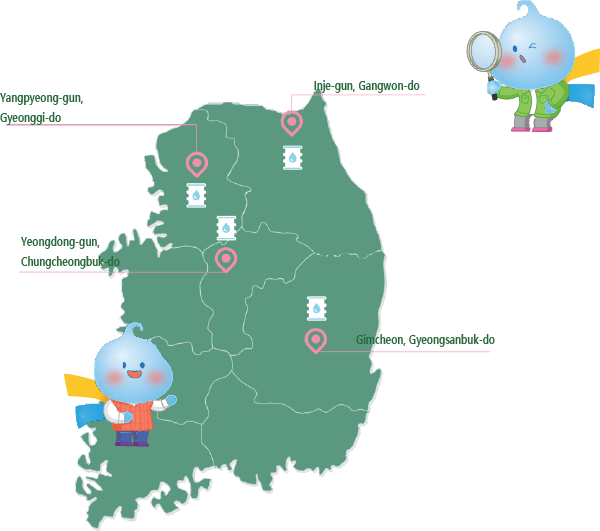
Ensuring access to clean and safe water for all with better water supply systems
K-water has been implementing a number of projects in order to address the difficulties facing residents of areas with poor water supply.
One of the projects is improving water supply facilities at military camps. K-water was directly involved in improving the old water supply facilities of front-line army units from 2015 to 2017, launching a smart water management project for the Air Force Academy in 2016. It is also working to introduce a smart water management system for the 15th Fighter Wing in 2020.
However, military units on the front line and remote islands are still experiencing water supply issues. In order to address these issues, the Ministry of National Defense, Ministry of Environment, K-water, and Korea Environment Corporation signed an agreement on the improvement of water supply systems and environment management at military units in December 2021.
All of the signatories agreed to work together on developing ways to ensure stable water supply and manage water quality for military units suffering from limited water supply. They will also take actions to prevent soil and groundwater pollution caused by oils used at military facilities and activities at the shooting ranges and to have the soil and groundwater purified at the early stage of pollution; thus improving the water welfare for soldiers.
To this end, K-water assists in designing a “basic plan for water supply improvement” for the water supply facilities at military units in order to expand, improve, and manage water supply infrastructure in a more organized manner. It will also help improve water supply systems at military units on the front line and on remote islands that require immediate actions while introducing smart water management systems.
In addition, K-water is planning to provide drinking water including bottled water in case of disasters, introduce and expand smart water management systems at military units, offer professional education programs on the operation and management of water supply facilities, conduct joint R&D on water use and water quality at military units, and provide technical assistance and education on groundwater development and management as part of comprehensive cooperation efforts under the agreement.
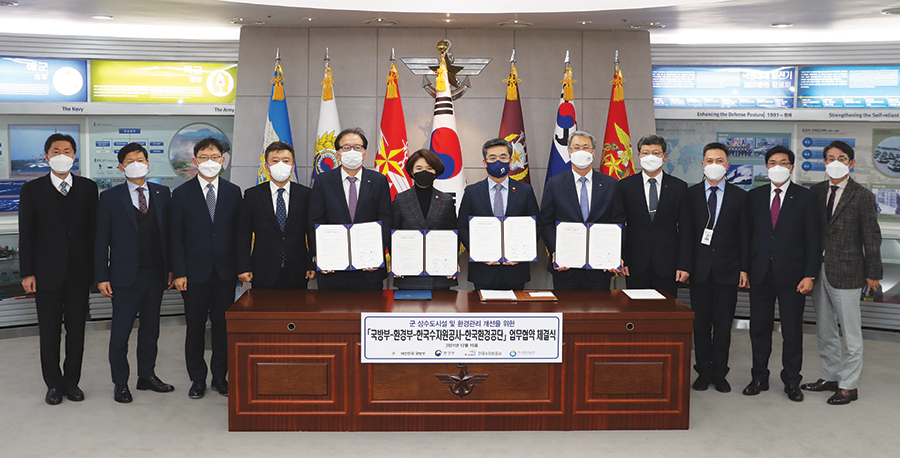
Water Supply Rates at Military Units in Korea(2019)
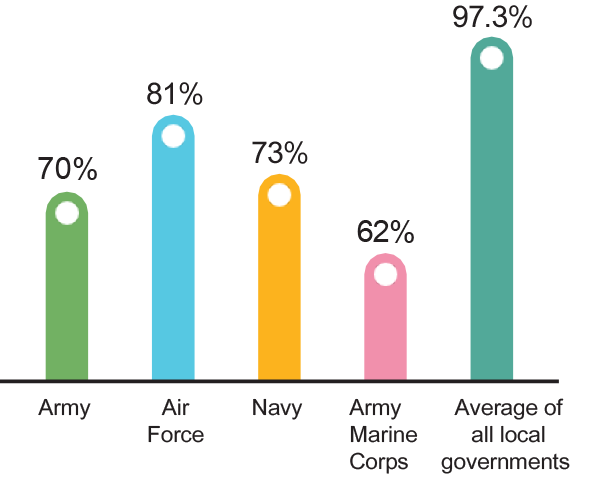

What is a smart water management system?
A smart water management system is an integrated operation and monitoring system designed to maintain optimal levels of water pressure, detect problems with water quality at an early stage, and prevent wastage of water.

